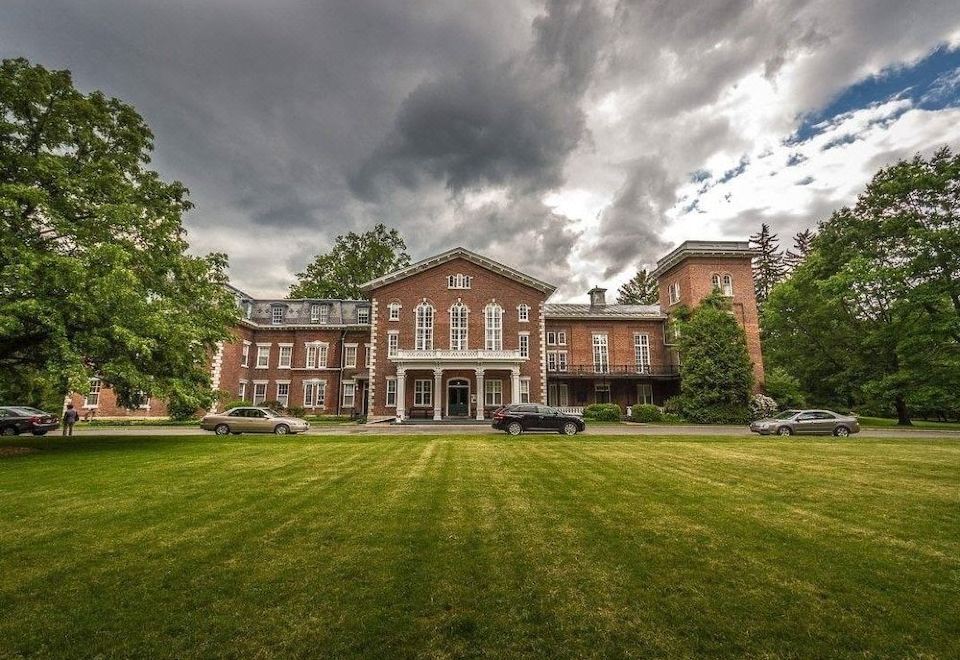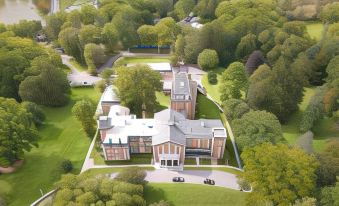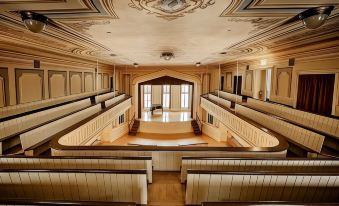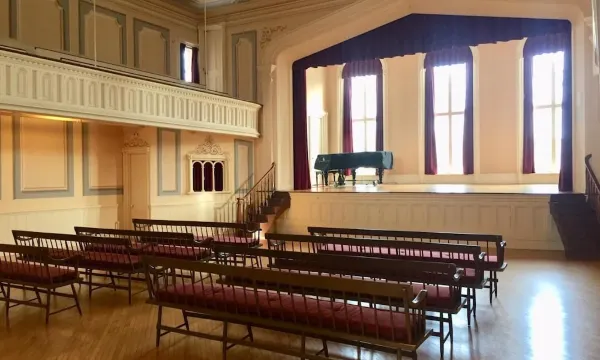Oneida Community Mansion House
0 nights
Rooms and Guests
1 room, 2 adults, 0 children
All Properties in Oneida
Oneida Community Mansion House
170 Kenwood Ave, Oneida, New York State, 13421, United States
Show on Map
With a stay at Oneida Community Mansion House in Oneida, you'll be within a 10-minute drive of Turning Stone Casino and Oneida Community Mansion House. This guesthouse is 3.4 mi (5.5 km) from Oneida Health Hospital and 4.5 mi (7.3 km) from Cross Island Chapel.Show More
We Price Match







4.4/5Very Good·Cleanliness: 4.4
All 41 Reviews
Amenities
Golf CourseHikingPublic ParkingFreeMeeting RoomWi-Fi in Public AreasFree
All Amenities
Surroundings
Landmarks: Oneida Community Mansion House
(<100m)
Landmarks: Oneida Community Golf Club
(350m)
Landmarks: City of Sherrill Community Activity Center
(600m)
Map
Rooms
Guest Reviews
Trending Questions
Policies
Services & Amenities

2
Deluxe Double Room, Ensuite, Courtyard View (Full Bed Guest Room)
1 Double bed
Free Wi-Fi
Non-smoking
Air Conditioning
TV
Cable Channels
In-room Wi-Fi
Check Availability

7
Premium Double Room, Ensuite, Courtyard View (Queen Bed Guest Rooms )
1 Queen bed
Free Wi-Fi
Non-smoking
Air Conditioning
Private Bath
Refrigerator
TV
Check Availability

4
Deluxe Twin Room, Ensuite (Twin Bed Guest Rooms )
2 Single bed
Free Wi-Fi
Non-smoking
Air Conditioning
Private Bath
Refrigerator
TV
Check Availability

4
Deluxe Double Room, Ensuite, Courtyard View (King Bed Guest Rooms)
1 King bed
Free Wi-Fi
Non-smoking
Air Conditioning
Private Bath
Refrigerator
TV
Check Availability

4
Double Room, 1 Queen Bed, Ensuite, Courtyard View (Queen Bed Guest Rooms )
1 Queen bed
Free Wi-Fi
Non-smoking
Private Bath
Refrigerator
In-room Wi-Fi
Towel
Check Availability

5
Standard Double Room with King Size Bed
1 King bed
Free Wi-Fi
Non-smoking
Air Conditioning
Refrigerator
Cable Channels
In-room Wi-Fi
Check Availability

3
Standard Double or Twin Room
1 Double bed or 2 Single bed
Free Wi-Fi
Non-smoking
In-room Wi-Fi
Towel
Garden View
Bedding: Blanket Or Quilt
Check Availability

4
Superior Room
1 King bed
Free Wi-Fi
Non-smoking
Air Conditioning
Refrigerator
Cable Channels
In-room Wi-Fi
Check Availability
Hide Room Types
Guest Reviews(41)
4.4/5
Very Good
 Verified Reviews
Verified Reviews- Cleanliness4.4
- Amenities4.4
- Location4.4
- Service4.4

Verified traveler
December 14, 2023

The staff is beyond amazing! Both in hospitality and knowledge of the history. The building is extremely clean and tidy, inside and out. Great location and comparable prices.

Edmond
September 25, 2023

This was a unique experience. The history of the place is fascinating. Architecturally its an authentic 150 year old mansion and very well preserved. They do have TV and wifi and an elevator, but dont expect modern. Breakfast was basic muffins & oatmeal. It would be nice if they had an actual restaurant. There are lovely gardens, but not much around the area. If You ever wanted to stay in a 200 room 19th century mansion this is it. There were not many guests so much of the place was empty and looks much the way it did 100 years ago. We loved it.

Mary
September 14, 2023

For a historical home it was very comfortable. Not really knowing what to expect, we were very happily surprised by how beautiful it was and how nice the condition was

Pamela
July 18, 2023

What a gem! Beautiful historic property with lovely grounds and gardens, fascinating museum on the first floor. Rooms are large and have new bathroom facilities and window air conditioning units.

Bradley
July 17, 2023

Of historical interest, in process of renovation, quaint large comfortable rooms. Large grounds, interesting museum on site about the mansion's own story.

Julie
July 20, 2023

Very unique hotel with loads of character and charm. Extremely small room, but was clean and cozy.

thomas
July 10, 2023

Great staff that was very friendly and couldn't be more helpful. Very unique building and very quiet neighborhood.

Amber
June 22, 2023

Really cool place to stay. Rooms were very clean and unique. There was a free tour and learned a lot about the property.

Greg
June 14, 2023

If you are only interested in a bed for the night, go elsewhere. If you love history, this is a must stay. Clean and charming. Very old and shows it in some places.
Property Policies
Check-in and Check-out Times
Check-in: 15:00–20:00
Check-out: Before 11:00
Front desk hours: [Mon-Sun]09:00–20:00
If you will arrive outside of check-in hours, contact the property in advance
Child Policies
Children of all ages are welcome at this property.
Cribs and Extra Beds
Please contact the hotel for details about crib and extra bed policies.
Breakfast
TypeContinental
| Age | Fee |
|---|---|
Adult | Contact hotel |
Additional breakfast fees are not included in the total and need to be paid at the property.
Show More
Property Description
- Number of Rooms: 11
With a stay at Oneida Community Mansion House in Oneida, you'll be within a 10-minute drive of Turning Stone Casino and Oneida Community Mansion House. This guesthouse is 3.4 mi (5.5 km) from Oneida Health Hospital and 4.5 mi (7.3 km) from Cross Island Chapel.
Take in the views from a garden and make use of amenities such as complimentary wireless internet access and wedding services.
Continental breakfasts are available daily from 8:00 AM to 10:00 AM for a fee.
Featured amenities include complimentary newspapers in the lobby, laundry facilities, and a library. Planning an event in Oneida? This guesthouse has 400 square feet (37 square meters) of space consisting of conference space and 3 meeting rooms. Free self parking is available onsite.
Make yourself at home in one of the 8 guestrooms. Conveniences include irons/ironing boards, and housekeeping is provided daily.
Take in the views from a garden and make use of amenities such as complimentary wireless internet access and wedding services.
Continental breakfasts are available daily from 8:00 AM to 10:00 AM for a fee.
Featured amenities include complimentary newspapers in the lobby, laundry facilities, and a library. Planning an event in Oneida? This guesthouse has 400 square feet (37 square meters) of space consisting of conference space and 3 meeting rooms. Free self parking is available onsite.
Make yourself at home in one of the 8 guestrooms. Conveniences include irons/ironing boards, and housekeeping is provided daily.
Services & Amenities
Most popular business facilities
Golf Course
Hiking
Public ParkingFree
Meeting RoomAdditional charge
Wi-Fi in Public AreasFree

Meeting Room
Show More